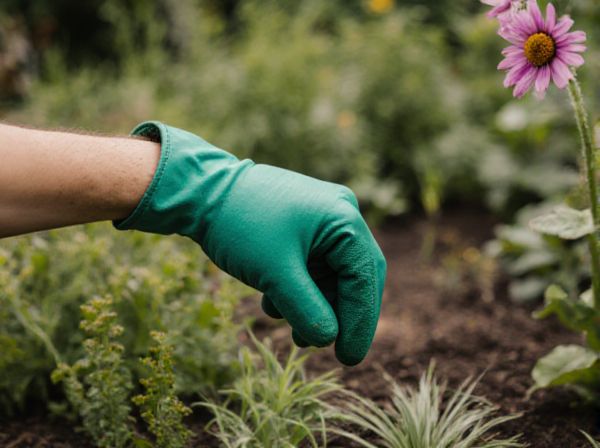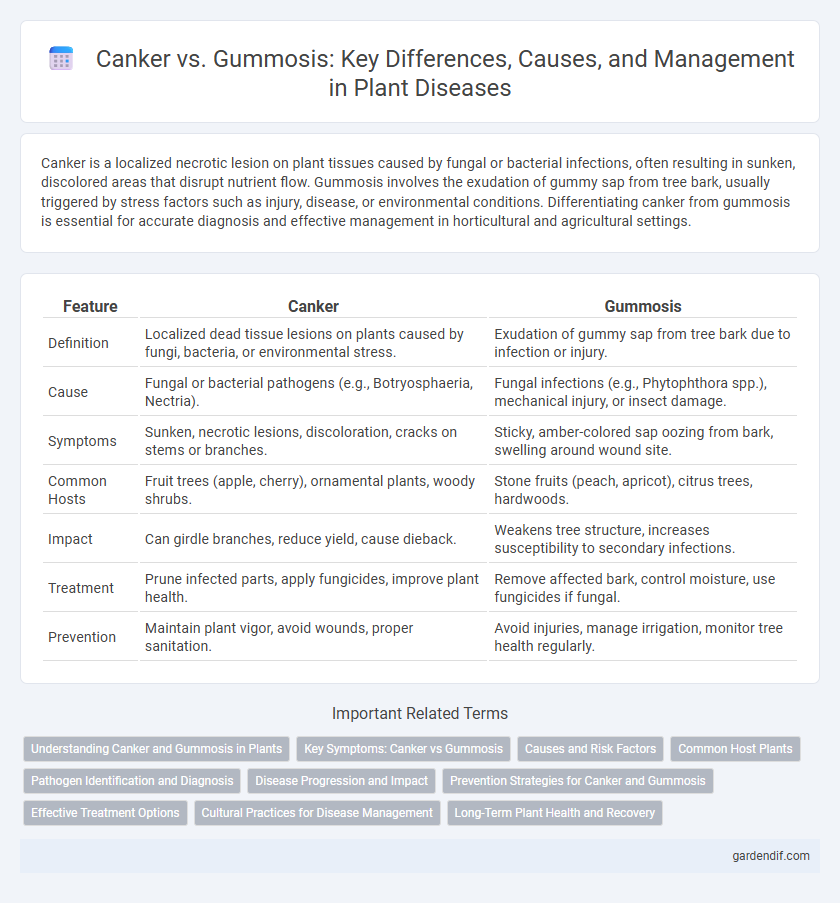
Canker vs Gummosis Illustration
Canker is a localized necrotic lesion on plant tissues caused by fungal or bacterial infections, often resulting in sunken, discolored areas that disrupt nutrient flow. Gummosis involves the exudation of gummy sap from tree bark, usually triggered by stress factors such as injury, disease, or environmental conditions. Differentiating canker from gummosis is essential for accurate diagnosis and effective management in horticultural and agricultural settings.
Table of Comparison
| Feature | Canker | Gummosis |
|---|---|---|
| Definition | Localized dead tissue lesions on plants caused by fungi, bacteria, or environmental stress. | Exudation of gummy sap from tree bark due to infection or injury. |
| Cause | Fungal or bacterial pathogens (e.g., Botryosphaeria, Nectria). | Fungal infections (e.g., Phytophthora spp.), mechanical injury, or insect damage. |
| Symptoms | Sunken, necrotic lesions, discoloration, cracks on stems or branches. | Sticky, amber-colored sap oozing from bark, swelling around wound site. |
| Common Hosts | Fruit trees (apple, cherry), ornamental plants, woody shrubs. | Stone fruits (peach, apricot), citrus trees, hardwoods. |
| Impact | Can girdle branches, reduce yield, cause dieback. | Weakens tree structure, increases susceptibility to secondary infections. |
| Treatment | Prune infected parts, apply fungicides, improve plant health. | Remove affected bark, control moisture, use fungicides if fungal. |
| Prevention | Maintain plant vigor, avoid wounds, proper sanitation. | Avoid injuries, manage irrigation, monitor tree health regularly. |
Understanding Canker and Gummosis in Plants
Canker in plants refers to localized dead areas on stems, branches, or twigs caused by fungal or bacterial infections, often leading to sunken lesions and bark cracking. Gummosis is characterized by the excessive exudation of sap or gum from wounds or infected plant tissues, typically triggered by stress, injury, or pathogenic attacks such as fungal infections. Recognizing the differences in symptoms and causes between canker and gummosis is essential for effective diagnosis and management of plant health.
Key Symptoms: Canker vs Gummosis
Canker presents as sunken, dead areas on bark with reddish-brown borders and often causes defoliation or dieback in affected plants. Gummosis is characterized by the oozing of sticky, amber-colored gum from wounds or lesions on tree trunks and branches, typically accompanied by swelling or decay beneath the bark. Both diseases indicate stress or infection but differ in visual symptoms and types of exudate produced.
Causes and Risk Factors
Canker is primarily caused by fungal or bacterial infections that invade plant tissues through wounds or natural openings, with environmental stress and poor sanitation increasing susceptibility. Gummosis results from mechanical injury, fungal pathogens like Botryosphaeria, or environmental stress such as excessive moisture and temperature fluctuations, leading to gum exudation from bark. Both diseases are exacerbated by factors including weakened plant health, improper pruning, and unfavorable climatic conditions.
Common Host Plants
Canker primarily affects woody plants such as apple, cherry, oak, and eucalyptus, causing localized dieback and sunken lesions on stems and branches. Gummosis commonly occurs in stone fruit trees like peach, plum, and apricot, characterized by the oozing of sap or gum from wounds or infections. Both diseases significantly impact fruit tree health and productivity, necessitating early identification and management.
Pathogen Identification and Diagnosis
Canker is primarily caused by fungal pathogens such as Botryosphaeria spp. and Nectria spp., identified through symptom examination and laboratory culture of lesions. Gummosis results from bacterial or fungal infections, particularly Pseudomonas syringae or Phytophthora spp., diagnosed by analyzing sticky gum exudate and conducting pathogen isolation tests. Accurate pathogen identification requires molecular techniques like PCR alongside visual assessments of characteristic symptoms for both diseases.
Disease Progression and Impact
Canker manifests as localized lesions on stems and branches, progressively killing bark tissue and disrupting nutrient flow, which leads to dieback and reduced plant vigor. Gummosis involves the abnormal exudation of sap or gum from wounds or infections, indicating underlying tissue decay and often signaling advanced stress or pathogen invasion. Both diseases significantly impair plant health by weakening structural integrity and increasing susceptibility to secondary infections, ultimately diminishing crop yield and quality.
Prevention Strategies for Canker and Gummosis
Prevention strategies for canker focus on maintaining tree health through proper pruning techniques, ensuring good air circulation, and avoiding injuries to the bark that serve as entry points for pathogens. In contrast, gummosis prevention involves controlling environmental stresses such as waterlogging and insect damage, as well as applying appropriate fungicides to reduce fungal infections. Both diseases benefit from regular monitoring and sanitation practices to remove infected plant material and reduce inoculum sources.
Effective Treatment Options
Effective treatment options for canker include topical antiseptics, corticosteroids to reduce inflammation, and proper oral hygiene to prevent secondary infection. Gummosis requires addressing underlying causes such as bacterial or fungal infections with appropriate fungicides or antibiotics, along with pruning affected plant tissue to improve air circulation. Early detection and consistent application of targeted treatments significantly improve recovery outcomes for both canker and gummosis.
Cultural Practices for Disease Management
Effective management of canker involves pruning infected branches during dry weather to reduce pathogen spread and applying protective fungicides to prevent infection. In gummosis control, maintaining tree vigor through balanced fertilization and proper irrigation minimizes stress that predisposes trees to gum exudation. Sanitation practices, such as removing dead bark and avoiding mechanical injuries, are critical in preventing both canker and gummosis diseases in orchard cultivation.
Long-Term Plant Health and Recovery
Canker causes bark lesions that disrupt nutrient flow, leading to dieback and reduced plant vigor, often requiring pruning and fungicide treatments to enhance long-term recovery. Gummosis involves excessive gum exudation from wounds or infections, indicating stress, but with proper wound care and improved cultural practices, plants can often recover and maintain health. Early detection and integrated management are critical to preventing chronic damage and ensuring sustained plant growth.
Canker vs Gummosis Infographic

 gardendif.com
gardendif.com